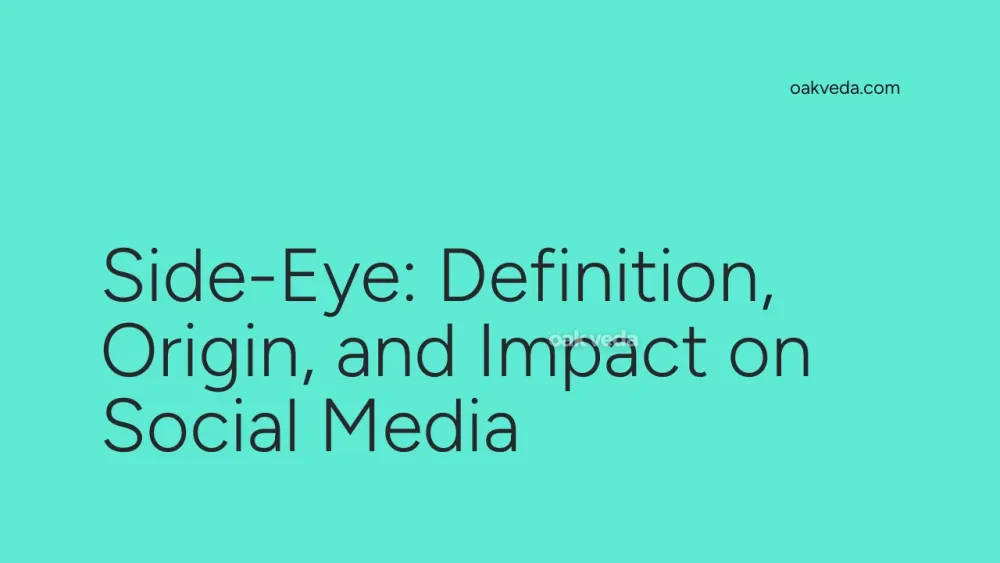
What is Side-Eye?
Side-eye, also known as "side-eyeing," is a popular expression used in social media to describe a skeptical or judgmental glance. It involves looking at someone or something out of the corner of one's eye, typically with a mixture of disapproval, suspicion, or disbelief. In the digital realm, side-eye has evolved from a physical gesture to a widely used term that conveys a range of critical reactions to online content, statements, or situations.
Origin and Development of Side-Eye
The concept of side-eye has existed in face-to-face interactions for centuries, but its prominence in social media culture is a relatively recent phenomenon. The term gained traction in the early 2010s as users began to incorporate more nuanced expressions of emotion in their online communications. As emoji and reaction GIFs became popular, side-eye emerged as a shorthand for expressing skepticism or judgment without the need for lengthy explanations.
How Side-Eye Works in Social Media
In the context of social media, side-eye functions as:
- A reaction: Users often comment with "side-eye" or use side-eye emojis (👀) to express their skepticism or disapproval of a post or statement.
- A meme format: Images or GIFs of celebrities or characters giving side-eye have become popular reaction memes.
- A hashtag: #SideEye is frequently used to categorize posts that critique or question various topics.
- A descriptive term: People use "side-eye" in captions or comments to describe their reaction to events or statements.
Popular Examples of Side-Eye in Social Media
Several iconic side-eye moments have become staples in social media culture:
- Sophia Loren's famous side-eye towards Jayne Mansfield in a 1957 photograph has been repurposed countless times on social media.
- Michelle Obama's perceived side-eye during Donald Trump's 2017 inauguration became a viral meme.
- The "side-eyeing Chloe" meme, featuring a young girl's skeptical expression, has been widely used to convey disbelief or judgment.
Impact of Side-Eye on Social Media Culture
The proliferation of side-eye in social media has had several notable impacts:
- Enhanced nonverbal communication: Side-eye allows users to convey complex emotions succinctly, enriching online interactions.
- Cultural commentary: The term has become a tool for social critique, often used to call out problematic behavior or statements.
- Brand engagement: Companies have incorporated side-eye into their social media strategies to appear relatable and in touch with current trends.
- Meme evolution: Side-eye has contributed to the development of reaction memes, a significant aspect of internet culture.
How Brands and Influencers Use Side-Eye
Savvy brands and influencers have embraced side-eye as part of their social media strategy:
- Reactive content: Brands use side-eye reactions to engage with current events or competitor actions.
- Relatable messaging: Influencers incorporate side-eye to create a sense of shared experience with their followers.
- Humor and critique: Companies use side-eye to playfully critique their own products or industry practices, demonstrating self-awareness.
Future Trends Related to Side-Eye
As social media continues to evolve, we can expect side-eye to adapt in the following ways:
- Increased visual representation: More sophisticated emojis and AR filters may offer new ways to express side-eye in digital communications.
- Cross-platform integration: The concept of side-eye may become more standardized across different social media platforms.
- Cultural variations: Different interpretations and uses of side-eye may emerge in various global online communities.
FAQs about Side-Eye
-
Is side-eye always negative? While often used critically, side-eye can also be playful or used in jest among friends.
-
Can side-eye be misinterpreted? Yes, like many online expressions, side-eye can be misunderstood, especially across different cultures or contexts.
-
How do you use side-eye in text? You can simply type "side-eye" or use the eyes emoji (👀) to convey the expression in text.
-
Is side-eye appropriate in professional online settings? It's generally best to avoid using side-eye in formal professional communications, as it may be seen as unprofessional or disrespectful.
-
How has side-eye affected online discourse? Side-eye has provided a quick way to express skepticism or criticism, potentially encouraging more critical thinking in online discussions.
In conclusion, side-eye has become a powerful and nuanced tool in social media communication. Its ability to convey complex emotions and critiques in a concise, often humorous manner has cemented its place in online culture. As social media continues to shape how we interact, expressions like side-eye will likely play an increasingly important role in how we communicate our thoughts and feelings in the digital world.
You may be interested in:
- Influencer: Definition, Origin, and Impact on Social Media
- Soft-Launch: Definition, Origin, and Impact on Social Media
- Engagement Rate: Definition, Origin, and Impact
- PFP: Definition, Origin, and Impact on Social Media
- Social Media Handle: Definition, Origin, and Impact
- NPC (Non-Player Character): Definition, Origin, and Impact

